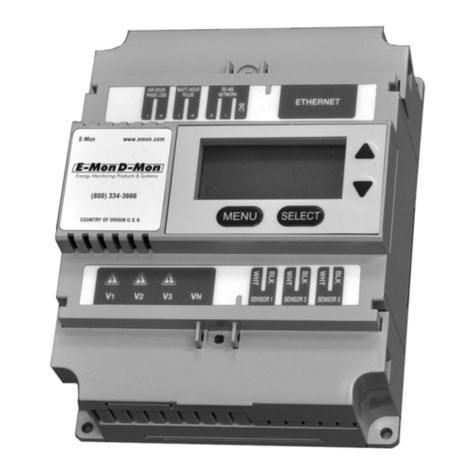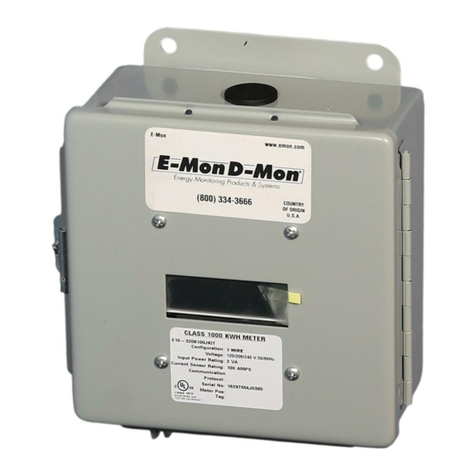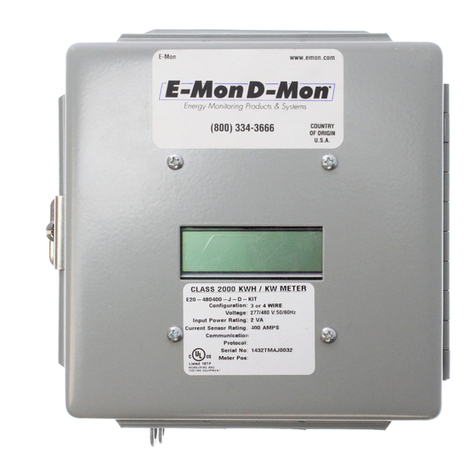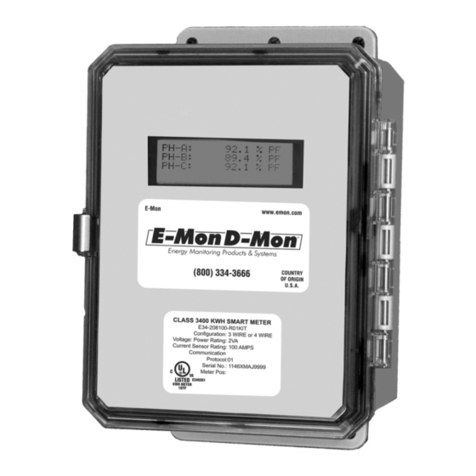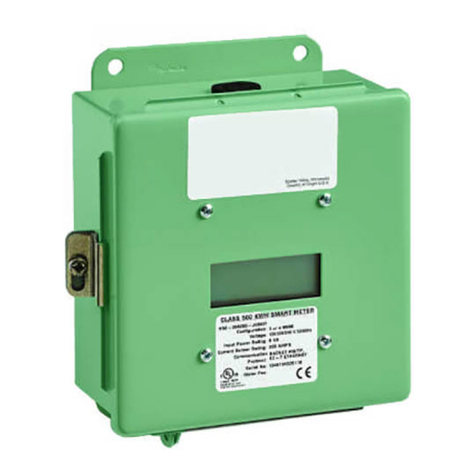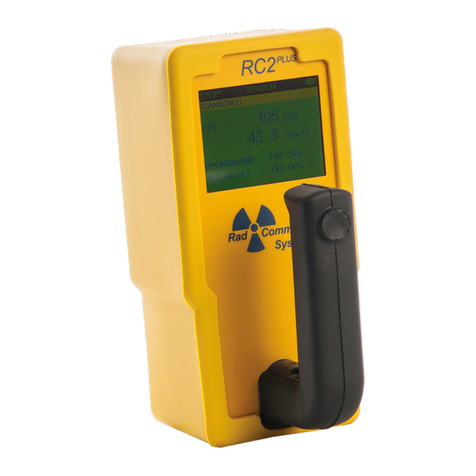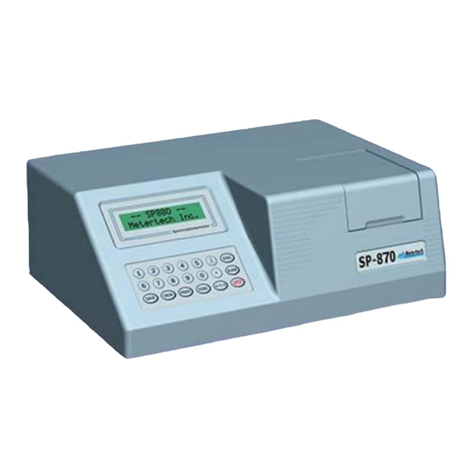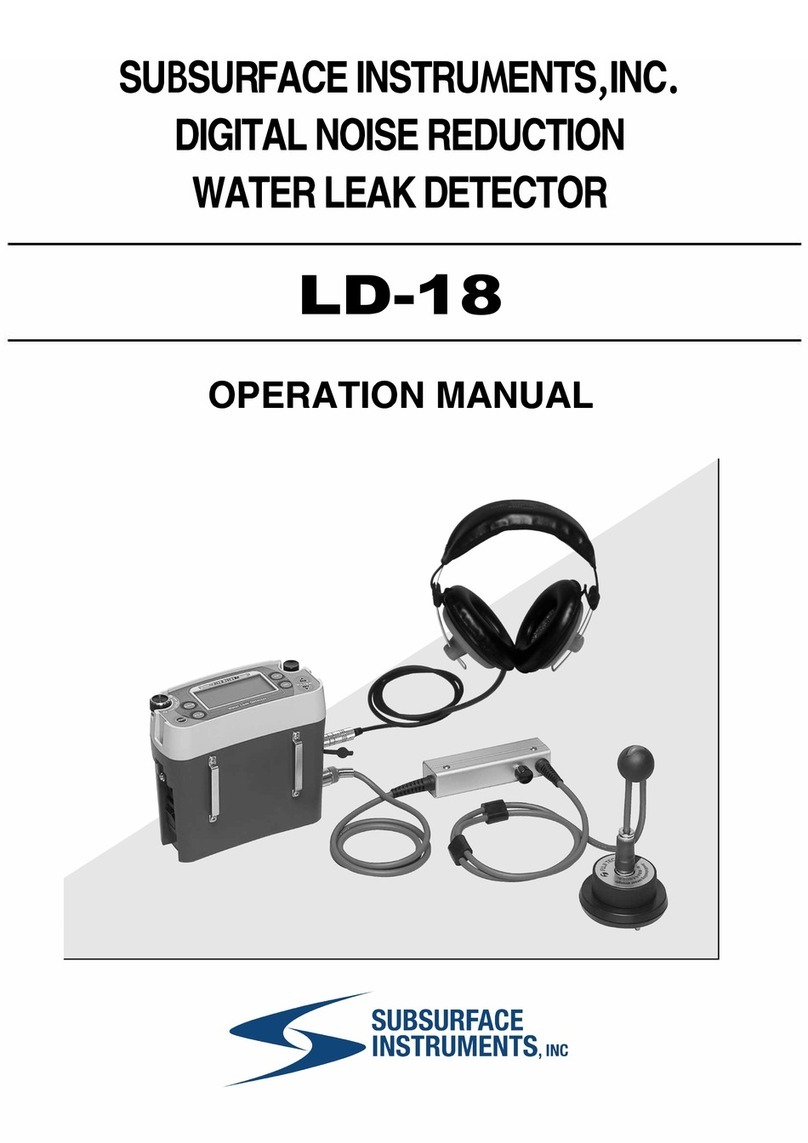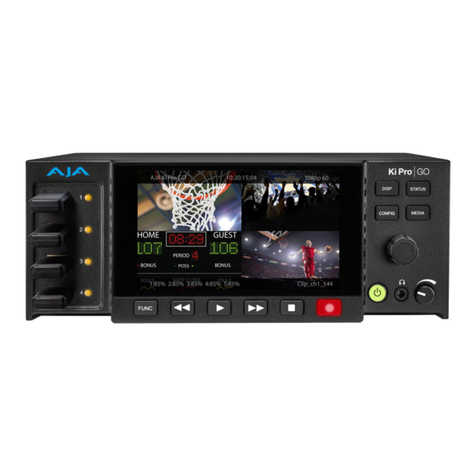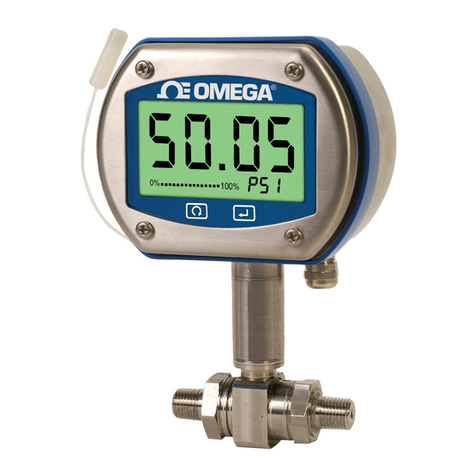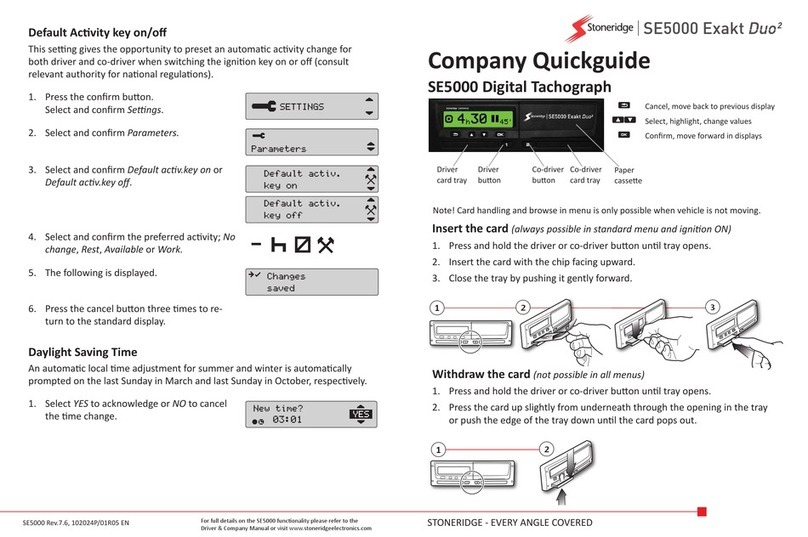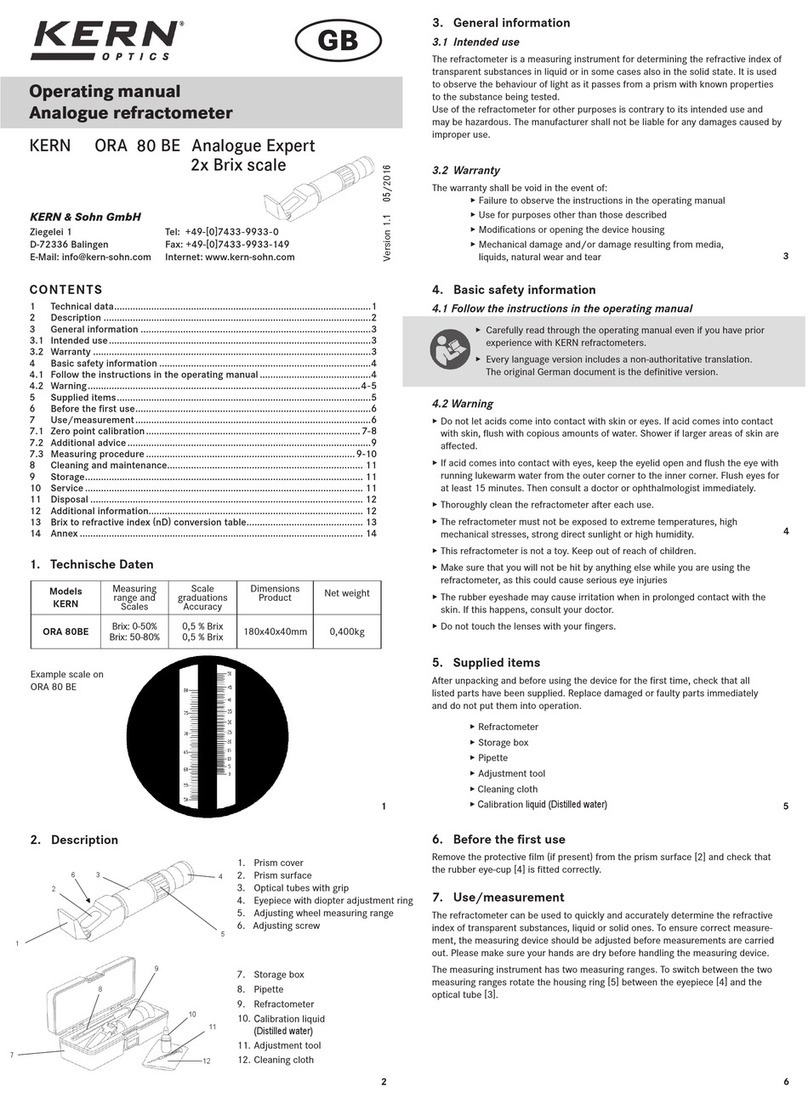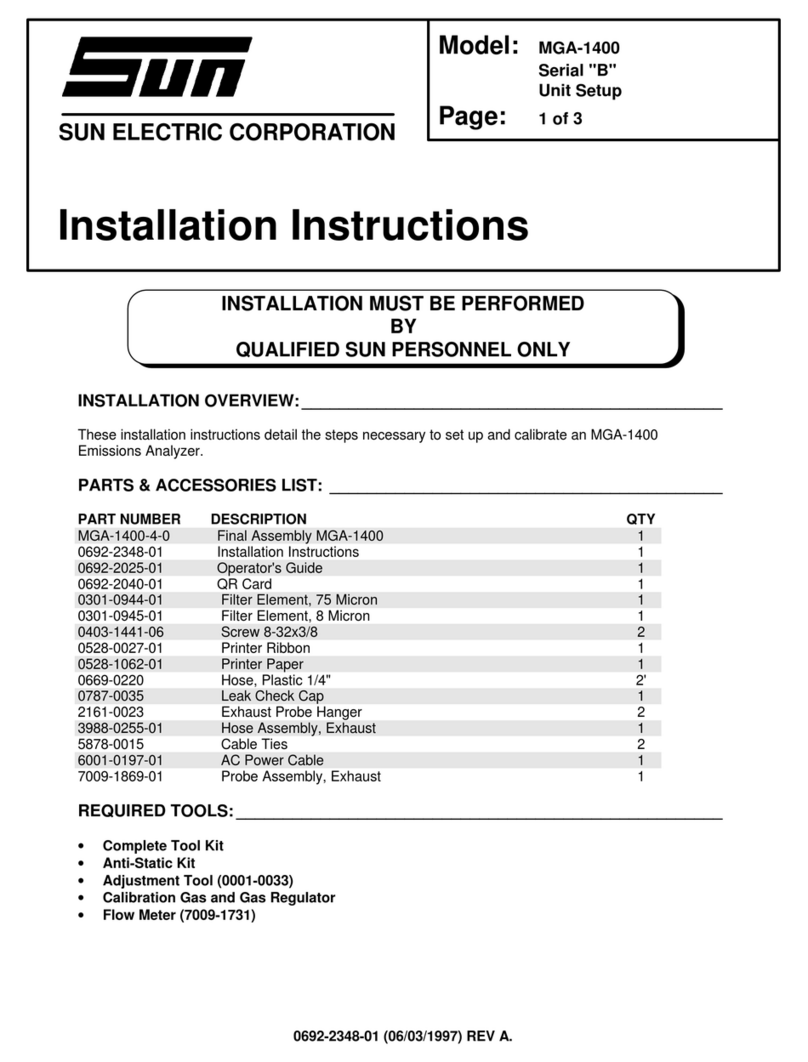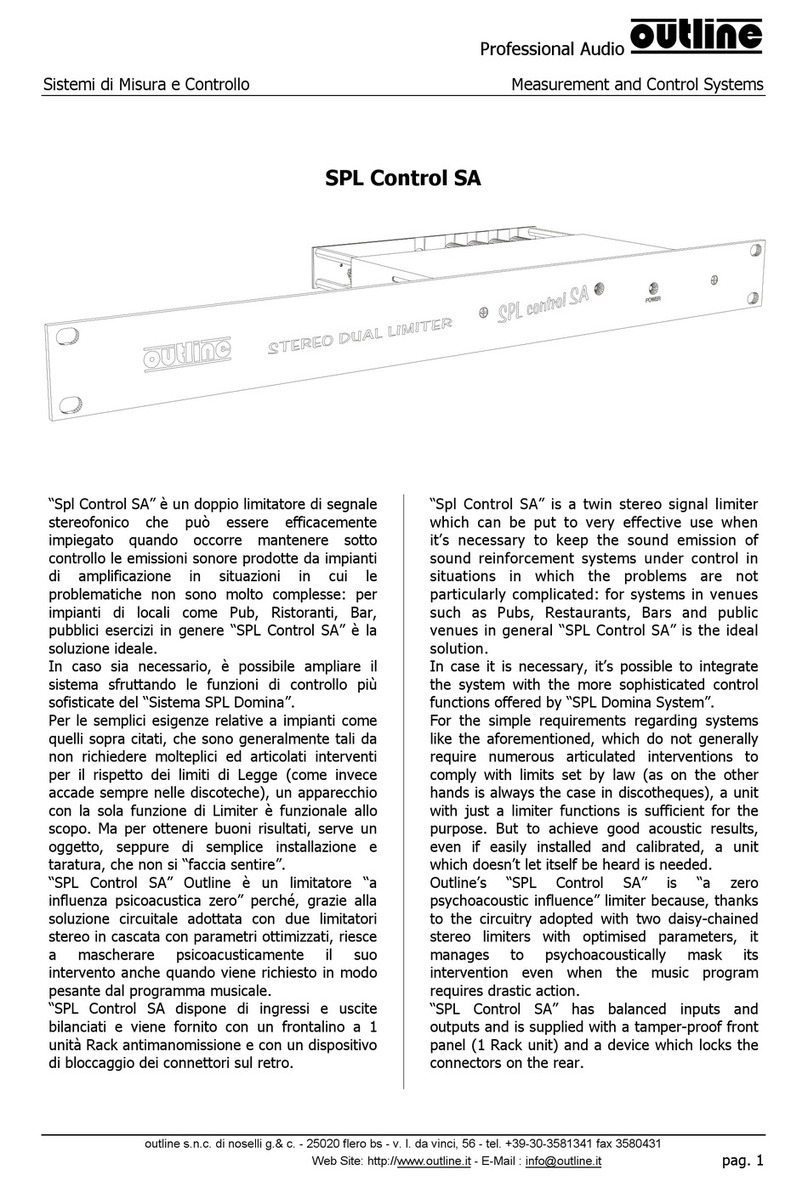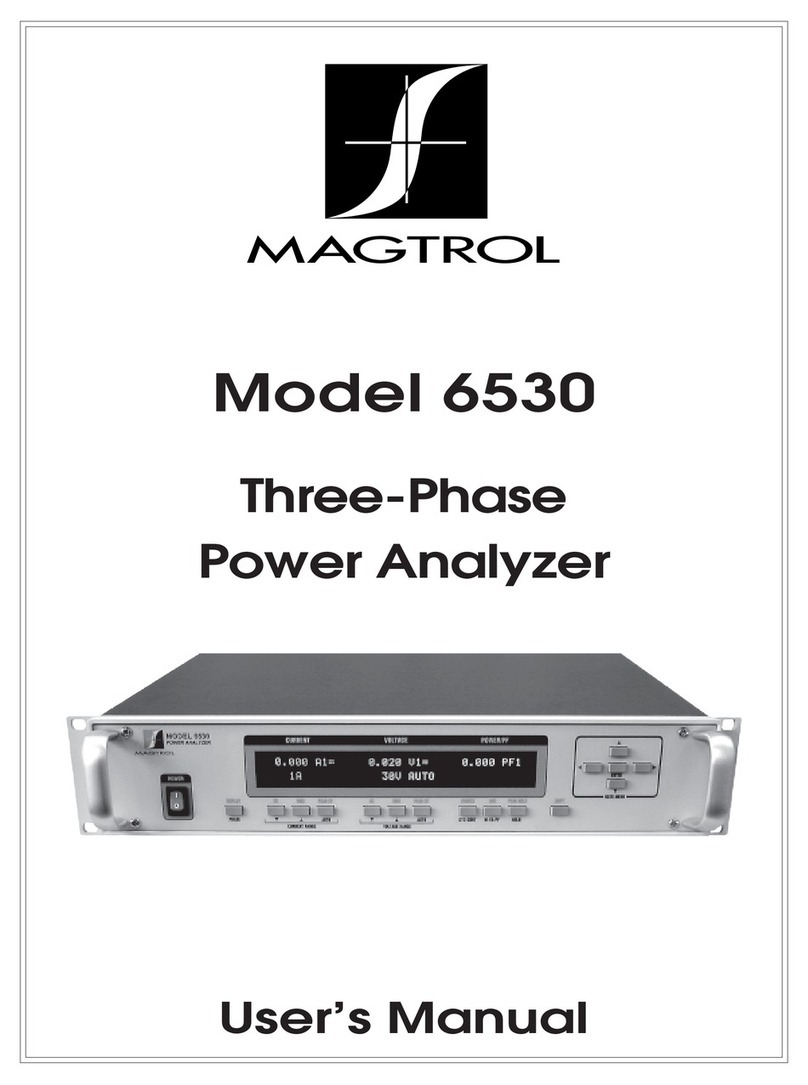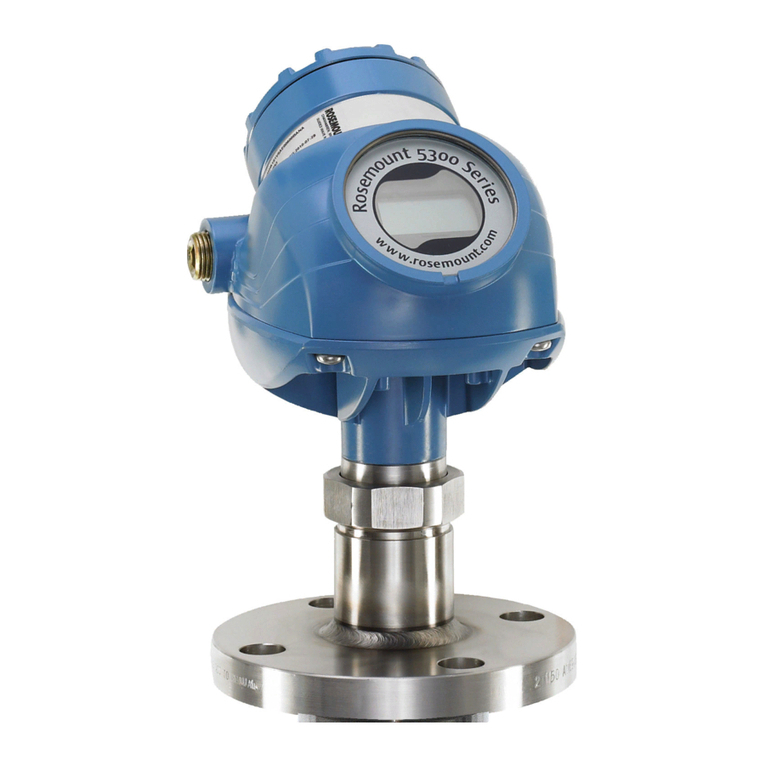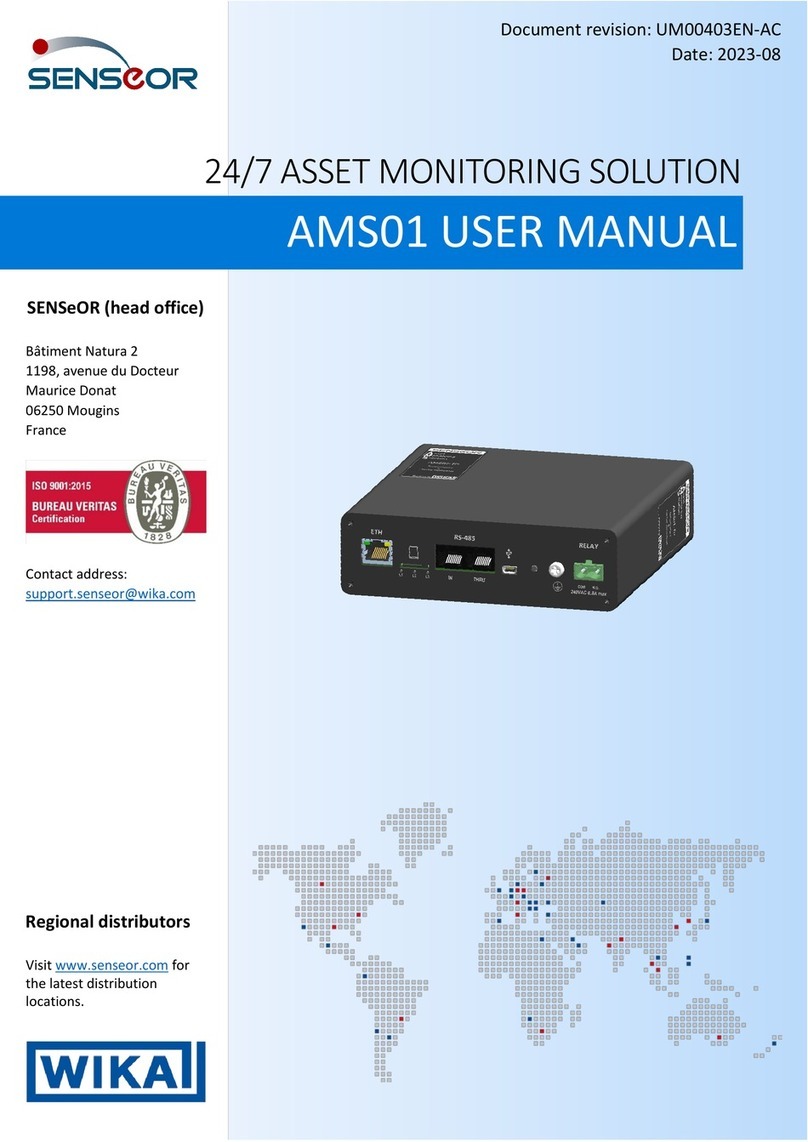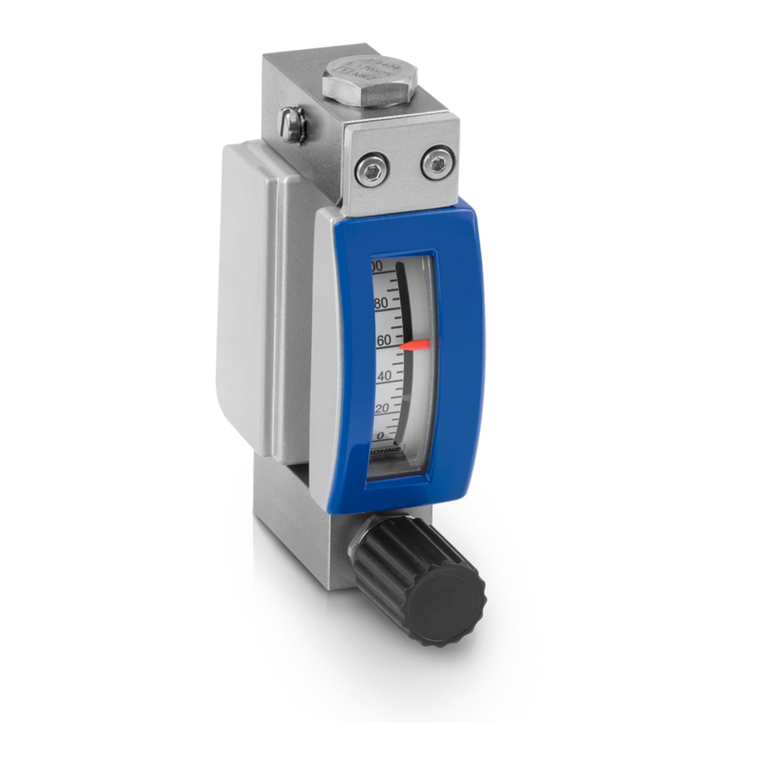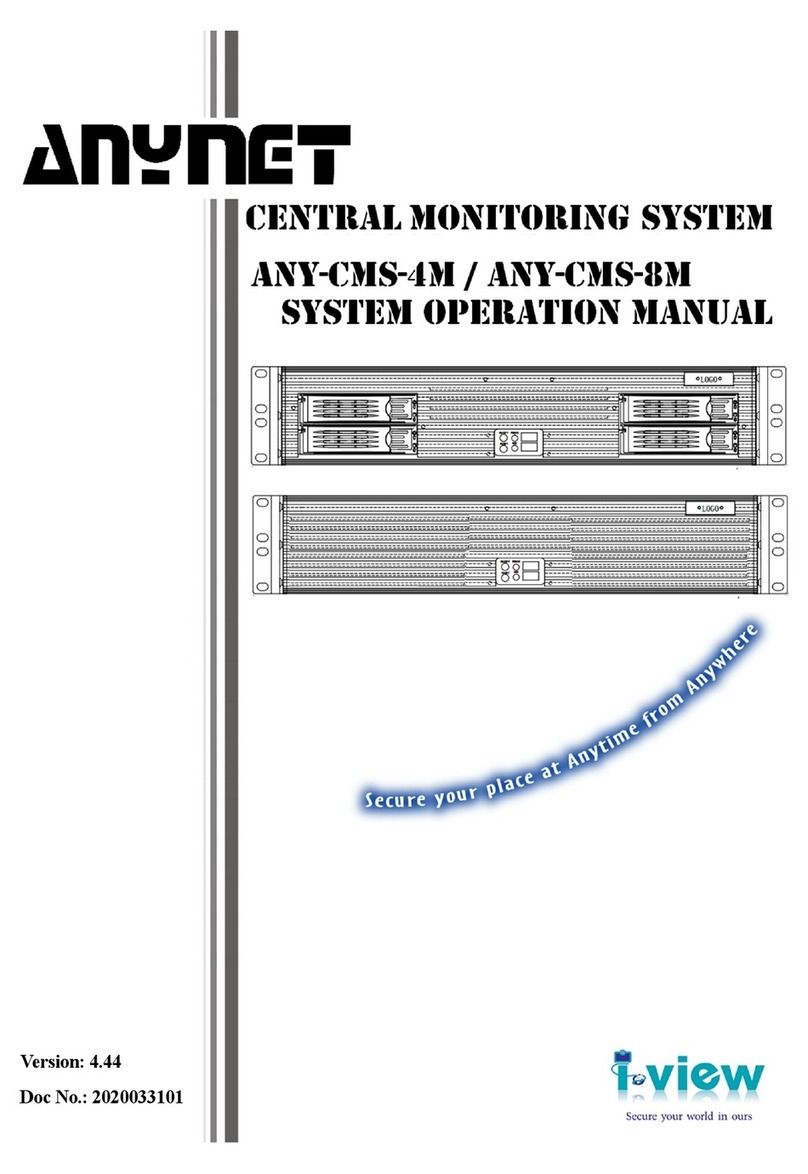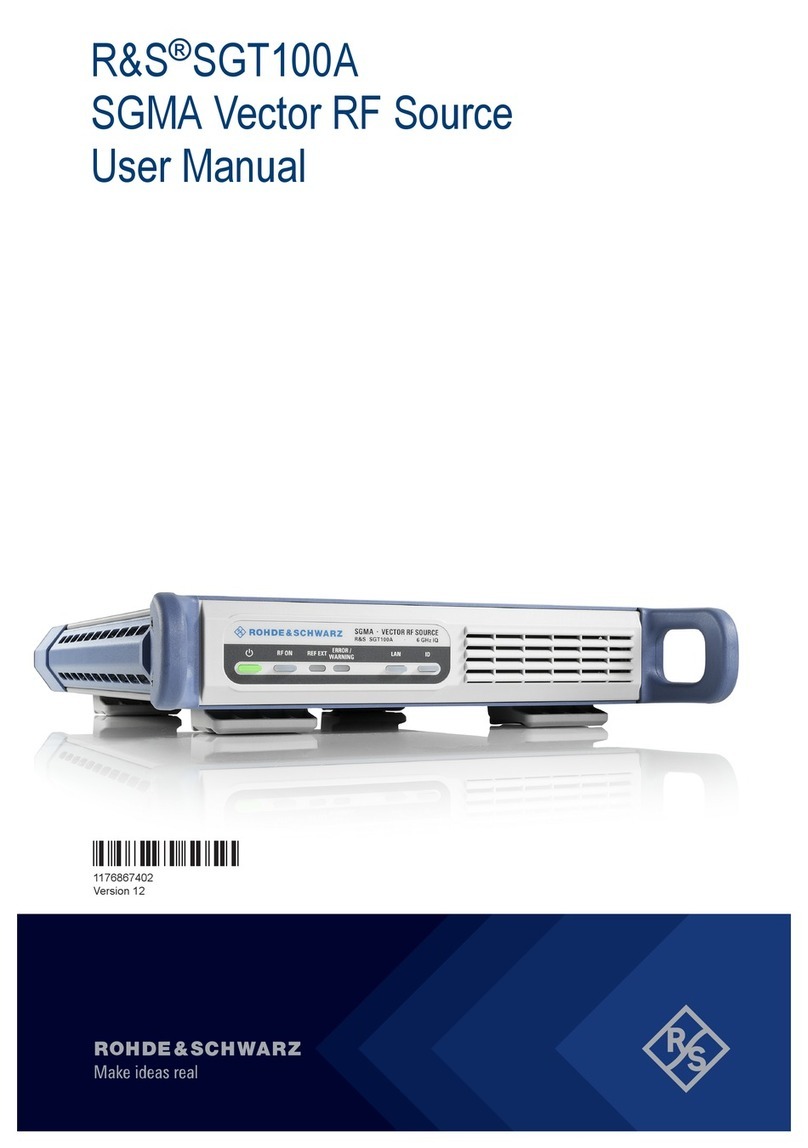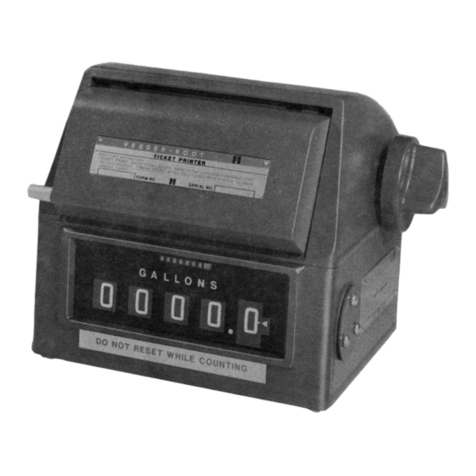E-Mon Class 3200 User manual

62-0390-02
INSTALLATION INSTRUCTIONS
Class 3200 Meter
ADVANCED KWH/DEMAND METER
Test Equipment Depot - 800.517.8431 - 99 Washington Street Melrose, MA 02176
TestEquipmentDepot.com

CLASS 3200 METER
62-0390-02 2
Dear Valued Customer,
We are pleased that you chose to buy one of our products, and want you to be just as
pleased with owning it. Before installing your new E-Mon product, please read the
information on the following pages carefully.
We believe that you will find the E-Mon D-Mon meters easy to install and to use for
monitoring and evaluating your electrical usage.
To be sure that you are 100% satisfied with your products, we provide toll-free
technical and sales support Monday through Friday, 8:00 am to 7:30 pm, EST:
If you have questions, we can handle them quickly and effectively with a telephone call.
Please let us try to help you BEFORE you remove your meter. And to help us help you,
we ask that you have all relevant information on hand when you call (model or part
numbers, nature of difficulty, etc.)
Be sure to forward this manual to the owner after installation is complete, so that they
may use it as a reference guide when reading the E-Mon D-Mon meter.
Thank you.

CLASS 3200 METER
3 62-0390-02
TABLE OF CONTENTS
Section 1.0 Introduction 4
Section 2.0 Internal Electronic Assemblies 6
Section 2.1 Main Power Board 6
Section 2.2 Display Board 7
Section 3.0 Meter Technical Specifications 8
Section 4.0 Safety Label Definitions and Information 10
Section 5.0 Precautionary and Safety Information 11
Section 6.0 Meter Installation 12
Section 6.1 Mounting the Class 3200 Meter 12
Section 6.2 Main Power Board Connections 12
Section 6.3 Phasing of Line Voltage 15
Section 6.4 Current Sensor Installation & Wiring 16
Section 6.5 Main Power & Current Sensor Wiring Diagram 18
Section 6.6 Line Voltage/Current Sensor Diagnostics 18
Section 6.7 RS-485 Wiring 19
Section 6.8 RS-232 Communications 22
Section 6.9 Modem Wiring 24
Section 6.10 Modbus RTU Wiring 27
Section 6.11 BACnet MS/TP Wiring 28
Section 6.12 Connecting Class 3200 Meters to USB Key using RS485 28
Section 6.13 Ethernet Communications 29
Section 7.0 Multiple-Load Monitoring 30
Section 8.0 Preventative/Scheduled Maintenance 31
Section 9.0 Lithium Battery Replacement 32
Section 10.0 Class 3200 Meter Operating Modes 34
Section 10.1 Start Up Screens 34
Section 10.2 Normal Mode Display Screens 35
Section 10.3 How to Program the Display Screens 36
Section 11.0 High Voltage Metering 41
Section 12.0 Class 3200 Protocol Definitions 45
Section 13.0 Meter Limited Warranty 51

CLASS 3200 METER
62-0390-02 4
1.0 INTRODUCTION
The E-Mon D-Mon® Class 3200 meter is a 3-element meter with communications. The
device is used to monitor electric power usage of individual loads after the utility meter
and store kW and kVAR data for automatic meter reading. Installation must only be
performed by qualified personnel and in accordance with these instructions and all
applicable local and national electrical codes. E-Mon and its representatives assume
no responsibility for damages or injury resulting from the improper installation of this
meter.
Verify the input voltage rating and configuration on the unit panel label to ensure that it
is suitable for the intended electrical service. Class 3200 meters labeled for 120/208V
service MUST NOT be installed on service feeds of 277/480 volts or 347/600 and vice
versa.
Verify that the Class 3200 meter’s current sensors are sized suitably for the load to be
monitored. Compare the color of the arrows on the current sensors to the chart below
to confirm the correct current sensor is being used.
Sensor Arrow Color Code Sensor Rating
Brown 100 A
Red 200 A
Yellow 400 A
Black 800 A
Blue 1600 A
White/Black 3200 A

CLASS 3200 METER
5 62-0390-02
CAUTION
Internal circuit components are extremely sensitive to electrostatic discharge.
Prior to handling or touching internal circuitry, discharge any static buildup on
your person. To discharge yourself, touch a grounded metal object such as
conduit or an earth-grounded enclosure.
WARNING
Use of this instrument, the E-Mon D-Mon Class 3200 meter, in a manner
inconsistent with this manual or not specified by the manufacturer in writing,
can cause permanent damage to the unit and/or serious injury to the operator.
The protection and safety features provided by this equipment may become
impaired or otherwise compromised.
NOTE: If any trouble arises during the installation or functional verification opera-
tions, do not immediately remove the unit. Before removing the unit, contact
E-Mon’s technical support and/or engineering department at (800) 334-3666.
E-Mon’ s technical department will assist you in detailed troubleshooting of
the Class 3200 meter installation and assist you in getting the unit operating
correctly.

CLASS 3200 METER
62-0390-02 6
2.0 INTERNAL ELECTRONIC ASSEMBLIES
The units are comprised of two major subassembly boards, the main power board and
the display board. Both circuit boards are mounted inside a UL Type 1 or Type 4X
enclosure.
Fig. 1. Internal Electronic Assemblies.
2.1 Main Power Board
Connections to this board include the MAIN Power Input and current sensors.The
MAIN Power Input terminals are positions one through four on the four position screw
terminal block, TB1. These terminals are covered with a protective shield for safety
purposes. The current sensor assemblies interface to TB2, TB3 and TB4. Each
terminal block corresponds to an input voltage phase; care must be exercised to
ensure that each current sensor is connected to the correct terminal block. One three
terminal screw connector is provided for RS-485 communications.
Fig. 2. Main Power Board Connections.
M33307
MAIN
POWER
BOARD
DISPLAY
BOARD
M33308
RS-485
TB1
POSITIONS
1-4
TB2, TB3,
TB4

CLASS 3200 METER
7 62-0390-02
2.2 Display Board
The display board connects to the main power board via a flex ribbon cable and the
board mounts on the inside of the housing door.
The Class 3200 meter features a 4-line LCD display that indicates multiple meter data
points.
Fig. 3. Display Board.
M33279
DOWN UP SELECT MENU

CLASS 3200 METER
62-0390-02 8
3.0 METER TECHNICAL SPECIFICATIONS
Ordering Information: Define brand, class, input voltage, amperage, protocol, and
sensor type in the format A-BB-CCC-DDDD-E-FFF-GGG, where
A = Brand: E for E-Mon
BB = designates Class: 3200 (32), 3400 (34), or 5000 (50) meter
CCC = input voltage: (208, 480, 600, 120 volt for High Voltage)
DDDD = current rating: (100, 200, 400, 800, 1600, 3200, 25HV)
E = enclosure: J = metal (type 1), R = non-metallic (type 4X), M = MMU
FFF= protocol: RTU = Modbus, BAC = BACnet, EZ7 = proprietary
GGG = Sensors: KIT = split-core, SCS = solid-core, “blank” = none supplied
Input Voltage
Configuration
3-wire (delta) Or 4-wire (wye)
Mains Voltage Input Up To 600 VAC RMS available
Input Power 6 VA maximum rating
Current Sensor
Rating
Up To 3200 amps RMS AC available
Power Factor 0.5 leading or lagging
Line Frequency 50-60 Hz
Metering Accuracy ANSI C12.20
Temperature Range -20C to +50C
Relative Humidity
Range
0-95% non-condensing
Altitude 2000 meters maximum
Voltage Overload +25% continuously: +100% For 20 cycles
Current Sensor
Overload
100% for 1 minute
Pollution Degree Degree 2 in accordance with IEC 664
Installation
(Overvoltage)
Category
Category III
Measurement
Category
Category III
M33191
EXAMPLE: E 32- 208 200 J RTU KIT
E-MON
CLASS 3200 METER
INPUT VOLTAGE (208V)
CURRENT RATING (200A)
ENCLOSURE (METAL - TYPE 1)
PROTOCOL (MODBUS)
SENSORS (SPLIT-CORE)

CLASS 3200 METER
9 62-0390-02
3.0 METER TECHNICAL SPECIFICATIONS
(CONTINUED)
Enclosure Material UL Type 1 or Type 4X
Display Readout LCD
Standard Ranges (4-Wire Wye) 208 VAC: 100, 200, 400, 800,1600, 3200 Amp
(3-Wire Delta) 240 VAC: 100, 200, 400, 800,1600, 3200 Amp
(4-Wire Wye) 480 VAC: 100, 200, 400, 800,1600, 3200 Amp
(3-Wire Delta) 480 VAC: 100, 200, 400, 800,1600, 3200 Amp
(4-Wire Wye) 600 VAC: 100, 200, 400, 800,1600, 3200 Amp
RS-485 Serial
Communications
Cable
Cable: UL-listed/rated/3-conductor,
300 VAC, stranded
conductors, 22-26 AWG.
Input/output Voltage: Ground-isolated +/-5.4Vdc
Cable Connector: Screw terminal termination
Circuit Input Isolation: 5.3kVAC
Max Cable Distance: 4000 feet
Max Network Nodes: 64 cabling nodes (including
master)
Baud Rate: 9600, 19200, 38400, 76800
Recommended
In-Line Fuse
Manufacturer: Littlefuse
Mfg. Part No: KLDR.100
Rating: 100mA, time-delay, 600VAC
cartridge fuse
Battery Cell: Description: Non-rechargeable cell used for
memory retention
Manufacturer: Panasonic
Mfg Part No: CR2032
Working Voltage: 3Vdc
Current Capacity 225 mAHr
Electrolyte: Manganese Dioxide Lithium

CLASS 3200 METER
62-0390-02 10
4.0 SAFETY LABEL DEFINITIONS AND
INFORMATION
The 3200 meter may contain one or more of the following labels. Operator(s) should
familiarize themselves with the meaning of each label to minimize risk.
The presence of this label is a cautionary indicator identifying a
danger risk. The manual should be consulted prior to proceeding.
The presence of this label indicates an electrical shock hazard exists
in the location or area where the label is placed. Prior to proceeding,
the MAINS power must be disconnected and the manual consulted for
safety information.

CLASS 3200 METER
11 62-0390-02
5.0 PRECAUTIONARY AND SAFETY
INFORMATION
CAUTION
Internal circuit card components are extremely sensitive to electrostatic
discharge. Be careful not to touch internal circuitry prior to discharging any
static buildup on your person. To discharge yourself, touch a grounded metal
object such as conduit or an earth-grounded metal enclosure.
WARNING
High voltages present on main PCB terminal block TB1 screw terminals. Risk
of serious injury and/or electrical shock exists. Prior to performing any wiring
operations, review all contents of the user manual and de-energize the MAINS
power switch. Only qualified personnel should perform installation wiring.
Installation wiring must comply with all local and national electrical codes.
WARNING
Failure to ground the enclosure creates a possible shock hazard. Do not
operate the Class 3200 meter without a protective earth wire attached securely
to the PE terminal screw. After installing protective earth wiring, secure the
screw tightly (7in-lb torque.)
WARNING
NEVER open front panel of unit while unit has MAINS power applied. Failure to
comply can increase the risk of serious injury and/or electrical shock.

CLASS 3200 METER
62-0390-02 12
6.0 METER INSTALLATION
6.1 Mounting the Class 3200 Meter
Use appropriately sized mounting hardware to fasten the Class 3200 enclosure to the
selected mounting surface. The four housing mounting holes are centered 6.75” H x 4”
W. When the meter is provided in the 4X rated enclosure, the hub must be mounted to
the conduit first before connecting it to the enclosure.
NOTE: Units housed in UL type 1 enclosures must only be installed in indoor loca-
tions, where they will not be affected by the elements.
6.2 Main Power Board Connections
1. Installing a temporary ground for ESD protection: With all circuits de-energized,
connect a temporary protective earth ground connection for ESD protection.
Prior to performing any unit wiring, be sure to discharge any static on your per-
son.
2. Installing the Class 3200 protective earth ground: Connect an earth ground wire
to the Class 3200 (Type 1 enclosure) protective earth ground lug with a torque of
7 N-m.
WARNING
Failure to attach the protective earth ground wire securely to the meter creates
a potential shock hazard. Do not loosen or remove the screw securing the
ground lug.
Fig. 4. Main Power Board Connections.

CLASS 3200 METER
13 62-0390-02
6.2 Main Power Board Connections (continued)
3.
Wire Entry:
One 3/4” conduit opening is located on the bottom of the CL3200
enclosures. This opening is used for bringing in MAINS power and for current
sensor wiring. One 1/2” conduit opening on the top of the metal enclosure
CL3200 can be utilized as an interface for the low- voltage signals, pulse input,
or RS-485 communications wiring to the unit. CL3200 meters are available in an
MMU (Multiple Meter Unit) enclosure that holds eight (8) meters. This enclosure
comes without knockouts and allows the user to choose entry points for the wir-
ing.
Any unused openings must be sealed with a UL rated plugging device or hub
suitable for the rating of the enclosure - such as NEMA 1 or 4X
.
4. Unit MAINS wiring:
The four positions on terminal block TB1, located at the bottom left corner of the
main power board, are clearly labeled Phase A, B, C, N (neutral). Earth Ground
MUST be connected to the PCB mounting screw in the lower right corner.
A. Connect the NEUTRAL wire to the appropriate terminal block position.
Fig. 5. Terminal Block TB1, TB2, TB3, and TB4.
NOTE: For 3-wire delta-type applications, do NOT connect the NEUTRAL wire.
Remove the terminal block screw for this position.
B. Earth Ground
Connect the Earth Ground to the PCB mounting screw in lower right corner.
C. External Switch Mechanism/In-Line Fuse Installation
To ensure a safe installation, the Class 3200 meter requires an external
switch mechanism, such as a circuit breaker, be installed on the meter’s
MAINS input wiring. The switch mechanism must be installed in close prox-
imity to the meter and easily reachable for the operator. This device must
also be marked as the disconnecting device for the Class 3200 meter. 1/10
Amp Slow Activation in line fuses (KLDR.100, UL listed, Littelfuse rated
600V/100ma) must be installed for each conductor phase at the MAINS input
to the meter. The fuses must be labeled to indicate voltage and current rating
as well as element characteristics.The fuse element must be slow activating
type.

CLASS 3200 METER
62-0390-02 14
6.2 Main Power Board Connections (continued)
D. Connect the three AC main power wires (Phases A, B and C) to their respec-
tive positions as labeled on terminal block TB1. After all conductors are con-
nected to each of their respective terminal block positions and tightened to 7
in-lb, verify that each terminal block screw is securely fastened by gently tug-
ging on each conductor. Verify that no conductor wires are frayed or shorting
to adjacent terminal block positions.
E. Turn ON the AC main power input. The meter display will light up and scroll
through 6 displays. Each display is visible for 5 seconds. Display screens are
as follows:
Screen 1 - Total kilowatt-hours (kWh) consumed
Screen 2 - Peak demand (kW) with date & time stamp
Screen 3 - Actual load (kW)
Screen 4 - RMS Amps
Screen 5 - RMS Volts Phase to Neutral
Screen 6 - RMS Volts Phase to Phase
Screen 7 - Power factor (PF) per phase
F. Verify the voltage readings on Screen 5 using an AC voltmeter. Typical read-
ings shown below are measured phase to neutral (L-N) for 4 wire and phase
to phase (L-L) for 3 wire. Readings should be +/- 10% of nominal.
NOTE: Meters are powered by phases A and B. The displayed voltages will be the
measured AC voltage between phases.
Meter Type Nominal Voltage Limits (+/- 10%)
208V, 3ø, 4 Wire 120 VAC (L-N) 108 to 132 VAC
480V, 3ø, 4 Wire 277 VAC (L-N) 249 to 305 VAC
600V, 3ø, 4 Wire 347 VAC (L-N) 312 to 380 VAC
240V, 3ø, 3 Wire 240 VAC (L-L) 216 to 264 VAC
480V, 3ø, 3 Wire 480 VAC (L-L) 432 to 528 VAC

CLASS 3200 METER
15 62-0390-02
6.3 Phasing of Line Voltage
The 3-phase AC power input must be in proper phase sequence. If the sequence is
incorrect or a phase is missing, there will be a message on the meter’s display: “PH
Sequence Error” or “PH Missing:. (Refer to the section on Line Voltage Diagnostics if
this message is present.) When the line voltage is connected correctly, the meter’s
display will be blank (no message.)
Wait for the 4-line meter display to scroll to the voltage display. Verify that the meter
reads correct voltages on all three phases. Repeat Step 6.2.4F.
Once the meter displays the correct line voltages and there are no error messages,
you are ready to connect the current sensors to the meter. Before continuing with the
installation, verify that the six screens display as follows:
Screen 1 (kWh): Should read 0.0 kWh; if not, should be reset.
Screen 2 (kW Peak Demand): kW peak should read 0.0 kW. There will not
be a date/time stamp yet. If there is a kW
peak recorded, it should be reset later.
Screen 3 (kW Load): Should read 0.0 kW load.
Screen 4 (Amps per Phase): There should be 0.0 on all three phases.
Screen 5 (Volts RMS Phase to Neutral): See the section 6.2.4.F.
Screen 6 (Volts RMS Phase to Phase): See the section 6.2.4.F.
Screen 7 (Power Factor Per Phase): There should be 0.0 PF on all three phases.
NOTE: The meter will be reset later via the software during “startup” procedures.

CLASS 3200 METER
62-0390-02 16
6.4 Current Sensor Installation & Wiring
Once the AC voltages have been confirmed to be within acceptable limits, you are
ready to install the current sensors. TB2 is the input for Phase A, TB3 is the input for
Phase B and TB4 is the Phase C input.
The Class 3200 meter can be used with two types of current sensors:
1. Split-core current sensor. This sensor opens so that it can be attached around
the circuit being monitored without interrupting power.
2. Solid-core current sensor. This sensor does not open and requires the monitored
conductor to be removed from the circuit to install the current sensor. This type is
only supplied when specified at time of order.
NOTE: It is recommended that a UL listed current sensor be used for this application.
6.4.1 Installing the Split-Core Current Sensor Assembly
1. Each phase being monitored will require one two-piece current sensor assembly.
Open the two-piece current sensor assembly by releasing the nylon clamp using
a flathead screwdriver.
Fig. 6. Split Core Sensor.
2. Reassemble the current sensor assembly around the conductor(s) to be moni-
tored. Ensure the current sensor halves marked “Load” are both facing the load
side of the conductor. The colored arrow will be on the source side of the con-
ductor being monitored and MUST be pointed in a clockwise direction around the
conductor being monitored. Tighten the nylon clamp to complete the assembly.
Fig. 7. Split Core Sensor.
IMPORTANT:
When looking from the source side of the conductor(s) being monitored, you
should see the arrow on the current sensor assembly. The arrow should be
pointing in a clockwise direction around the conductor(s) being monitored. If
the arrow is not positioned on the source side, inaccurate readings will result.
M33213
LOAD
SOURCE

CLASS 3200 METER
17 62-0390-02
6.4.1 Current Sensor Wiring
Once the current sensors are installed onto their appropriate phase conductors, you
can begin terminating the current sensors onto the Class 3200 main board. The
current sensors can be extended up to 500 feet for remote monitoring applications. To
extend the length of the wires, use #22 AWG twisted-pair wire with one white and one
black wire.
The easiest way to connect the current sensors is to use the meter’s built-in current
sensor diagnostics. To do this, there must be at least 1% of the meter’s current rating
(amps) flowing in each of the conductors being monitored. The Class 3200 meter’s
diagnostic program (on the 4-line display) will provide data to ensure that the current
sensor installation is done properly.
The current sensor connection points are located at the bottom right of the main power
board. These are TB2, TB3, and TB4. Each sensor connects to two terminals one
labeled “Black” and the other “White.” Current sensors should be connected to the
meter one at a time and verified using the current sensor diagnostic program.
Connect one of the current sensors to the TB2 terminals (Phase A). Tighten the
terminal to 4.5 in-lb. Wait 5 seconds and look at the meter display.
If the meter displays an error message (see below), remove the wires from TB2 (Phase
A) and install them on TB3 (Phase B). if an error message occurs with the sensor
attached toTB3, try again on TB4 (Phase C). The wiring will be correct when the error
indication message is gone.
NOTE: If the power factor being monitored is <65%, the error message may be acti-
vated until improved. This is normal and indicates poor power factor.
The “CT Error: * “message will disappear when the current sensor is connected to the
correct terminals (phase).
Error Messages: CT ERROR: A
CT ERROR: A B
CT ERROR: A C
Refer to the section on Current Sensor Diagnostics for assistance in troubleshooting
these errors.
6.4.2 Main Power
After the meter circuit wiring has been examined for correctness, power may be
applied to the circuit board. There are three LEDs located in the upper right corner of
the Meter Board labeled BEAT, STATUS and LOAD. The BEAT and STATUS LEDs will
blink once per second when the meter is operating normally, twice per second if there
is a problem.If the monitored circuit is under load the LOAD LED will actively blink. A
heavy load will cause the LED to blink faster than a light load. Very light loads will
result in an extended blink time.

CLASS 3200 METER
62-0390-02 18
6.5 Main Power & Current Sensor Wiring Diagram
Fig. 8. 3-phase- 4 Wire Installation Diagram
6.6 Line Voltage/Current Sensor Diagnostics
Following is a list of diagnostic messages that may appear on the meter display.
DIAGNOSTIC MESSAGES SHOULD NOT BE ON CONTINUOUSLY WHEN THE
METER IS INSTALLED PROPERLY AND IS IN WORKING ORDER.
6.6.1 Line Voltage Diagnostics
The diagnostics program detects line voltage faults by displaying one of two
messages:
PH Missing: B C or Phase sequence error.
Phase sequence error
indicates that the 3-phase line voltage is not hooked up in the
proper phase sequence. This message should never be seen continuously on the
display during normal operation. The meter will not display correct electrical data in
this condition. The phase sequence problem must be remedied in order for the meter
to work properly.
Missing: B C
indicates that the line voltage is missing on Phase B and/or Phase C.
This message will appear whenever the power on either Phase B or Phase C is off.
Screen 5 (Voltage per Phase) will also indicate a loss of line voltage.
LINE VOLTAGE CURRENT SENSORS
N
LOAD SOURCE
M33185
3-PHASE, 4-WIRE INSTALLATION DIAGRAM
NOTES:
LINE VOLTAGE CONNECTIONS: #14-12 AWG
SENSOR CONNECTIONS: B = BLACK LEAD W = WHITE LEAD
NEUTRAL NOT USED IN DELTA SYSTEM. REMOVE NEUTRAL TERMINAL
BLOCK SCREW FOR DELTA SYSTEMS.
1/10A 600 VAC INLINE FUSE PER CONDUCTOR. LITTLEFUSE PART
NUMBER KLDR.100.
1
111
C
W B W B
NPE W B

CLASS 3200 METER
19 62-0390-02
6.6.2 Current Sensor Diagnostics
The load current must be at least 1% of the meter’s rated load in order to use the
diagnostic function. Current sensor diagnostics can detect:
1. Reversed current sensors
2. Incorrect phase correspondence
3. Unusually low power factor (0.642 or lower)
CT Error: (ABC) is used to detect the swapping of current sensor phases. This
message could (in some rare cases) indicate a low (<65%) power factor condition. This
message may appear intermittently due to changes in line conditions. It should not be
on continuously. (See Section 6.4.1.)
NOTE: If you have connected the current sensor to all three terminals and the error
message is still appearing, reverse the black and white wires and repeat the
previous steps until the correct connection is found.
If the
CT Error:
message disappears, you have found the correct sensor connection;
however, the current sensor was not installed properly around the conductor, or the
sensor wires were extended and not spliced together correctly. Correct the sensor
installation, reconnect the black wire to the black terminal and the white wire to the
white terminal on the plug and reinstall the plug into the correct phase terminal for that
current sensor. The error message should disappear and the current sensor is now
installed properly.
If the
CT Error:
message does not disappear at any time while trying all 3 inputs both
ways, check the AC voltage input from the current sensor between the black and white
wires using an AC voltmeter. It will read approximately zero volts indicating that the
load current is very small (or zero) or the current sensors are not secured properly
(tight connection between core halves or lead splices not secure.)
Once the first current sensor is connected properly and the error message disappears,
repeat the previous procedure for the remaining two current sensors. When all error
messages have disappeared and all sensors are installed correctly, the meter is
operational.
6.7 RS-485 Wiring
RS-485 communication allows a computer or modem to communicate with one or
more Class 3200 meters. You can connect as many as 52 meters along a 4000 foot
RS-485 cable run.
There are two communication protocols supported by the RS-485 connection; EZ7 and
Modbus RTU. The protocol is selectable via DIP switch S2, located on the Main Power
Board. If S2 position 1 is in the ON position, EZ7 is active. If S2 position 1 is in the OFF
position, Modbus RTU* is active. S2 position 2 is not used on the Class 3200. DIP
switch S2 positions 3 and 4 to select the Baud rate for the RS-485 communications.
See section 6.9.3 for details on Baud rate selection. After changing the DIP switch
positions, the CPU must be rebooted by pressing S1 to activate the changes.

CLASS 3200 METER
62-0390-02 20
6.7 RS-485 Wiring (continued)
* An alternate version of firmware is available that replaces Modbus RTU with BACnet
MS/TP.
The meter must be ordered with this option if BACnet is desired instead of
Modbus.
There are two connection methods, daisy-chain and wire terminal, for RS-485
communications.
Daisy-Chain Method
This is the simplest method for connecting meters together.
Fig. 9. Daisy-chain Configuration.
1. Connect the +(high) terminal of PORT 1 of each meter together so that the + ter-
minals on all meters are linked, + to + to +...
2. Connect the -(low) terminal of PORT 1 of each meter together so that the - termi-
nals on all meters are linked, - to - to -...
3. Connect the GND terminals of PORT 1 to meter 1 ONLY. The GND terminals
should not be linked to each meter.
4. Torque screws to 2.2 in-lb.
Fig. 10. RS-485 Terminal.
M32776
M33195
RS-485
TERMINAL
Table of contents
Other E-Mon Measuring Instrument manuals
